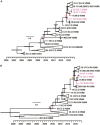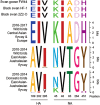Two reassortant types of highly pathogenic H5N8 avian influenza virus from wild birds in Central China in 2016
- PMID: 29410395
- PMCID: PMC5837153
- DOI: 10.1038/s41426-017-0012-y
Two reassortant types of highly pathogenic H5N8 avian influenza virus from wild birds in Central China in 2016
Abstract
Since 2016, the highly pathogenic avian influenza H5N8 virus has emerged in the Central Asian flyway and Europe, causing massive deaths in poultry and wild birds. In this study, we isolated and identified three H5N8 viruses from swan goose and black swans in Hubei province during the 2016/2017 winter season. Whole-genome sequencing and phylogenetic analysis revealed that the three viruses clustered into a group of H5N8 viruses from Qinghai Lake and Europe. A novel reassortment virus from swan goose was distinguished from that of black swans, in that its PA and NP genes were distinct from those of Qinghai Lake viruses. Molecular dating revealed that the ancestral strain of these H5N8 viruses emerged around July 2015. From sequence comparison, we discovered eight amino acid substitutions in HA and NA during the adaption process from poultry to wild birds. The three viruses were isolated from wild birds in the East Asian-Australasian flyway; however, the viral genomes were similar to H5N8 viruses circulating along the Central Asian flyway. From these data, we conclude that wetlands and lakes in Central China may play a key role in disseminating H5N8 viruses between the East Asian-Australasian and Central Asian flyways.
Conflict of interest statement
The authors declare that they have no conflict of interest.
Figures




References
-
- World Health Organization. Assessment of risk associated with influenza A (H5N8) virus. Geneva: WHO; 2016.
-
- The World Organization for Animal Health (OIE). Update on highly pathogenic avian influenza in animals (type H5 and H7). Available at: http://www.oie.int (accessed 17 April 2017).
MeSH terms
Substances
LinkOut - more resources
Full Text Sources
Other Literature Sources
Medical
Miscellaneous
